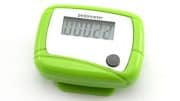The magic of pedometer is simple math.
Ok. The key to knowing more about pedometers is to know how the math works. If you understand the math, you understand the science and mechanism behind the wizard that is a pedometer. They are not all that complicated until you get to the smartwatch.
Americans are becoming increasingly sedentary than ever. Being sedentary is a problem even among people who exercise every day. A pedometer can surely help motivate you to exercise more but is not a cure-all, but it is a popular way people to coax more activity into their lives.
Americans walk about 5,100 steps a day. You should work out about 30 minutes a day in moderate-intensity exercise. This exercise is in addition to what you usually do at work. If your job is sedentary, you need to do more. 30 minutes of exercise is about 5000 steps, so you will complete about 10000 steps if you add 30 minutes to the average 5100 steps.
Step-by-step math:
- Stride: The average stride length is about two-and-a-half feet long for a 5′ 9″ male, although it might be a bit shorter for women, on average, than men because they tend to have shorter legs. Mine is slightly longer, but we will go with the average for this calculation. Stride length is critical for estimating the distance a person moves.
- Average Number of Steps: The average number of steps in a day is approximately 5900 steps which we will round up to 6000. Your day may include fewer steps if you are sedentary or have an office job. If you get up from your desk hourly, you will increase your step count.
- Math: So if you have an average stride and take 5,000 steps and have a stride length of 2.5 feet, you will walk 12500 feet with 5000 steps (2.5 feet per step x 5000 steps). This distance is equivalent to 2.37 miles (5280 feet per mile).
- 10,000 steps: To hit the 10000 step-a-day mark, you will have walked the equivalent of nearly five miles (10000 steps x 2.5 feet per step comes to 25000 feet which are just short of five miles. 4.73 approximately.).

Calories Math:
- The average number of calories burned per mile walking four mph is 100 kCal. That is about 2000 steps, so you would be expected to burn 500 kCal per 10000 steps.
- Each step accounts for 0.044 kCal if you ask at three mph. So, moving at 3mph for 2000 steps at 3mph accounts for 88 kCal burned.
- There are many other measurements out there, but none of them are very accurate unless they include age, gender, weight, height, pace, and a conversion constant for calories based on the speed.
The bottom line: Pedometers are not magic. They are simple counters that perform some basic math. If you understand how they work, you will understand the errors that come from them. They are a very useful tool that can help you be better motivated to exercise.








Be the first to comment on "Pedometers, Part 4: Step by Step Math"